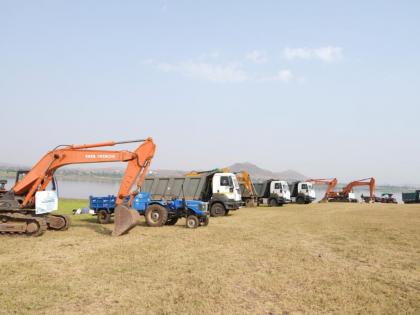Jalsamrudh Nashik Foundation's Slit Removal Project Under Scrutiny Amid Favoritism Allegations
By Chitra | Updated: May 10, 2024 15:51 IST2024-05-10T15:51:01+5:302024-05-10T15:51:13+5:30
Amidst allegations of favoritism and neglect towards local farmers, the slit removal project spearheaded by the Jalsamrudh Nashik Foundation, under ...

Jalsamrudh Nashik Foundation's Slit Removal Project Under Scrutiny Amid Favoritism Allegations
Amidst allegations of favoritism and neglect towards local farmers, the slit removal project spearheaded by the Jalsamrudh Nashik Foundation, under the leadership of Nashik district commissioner Jalaj Sharma, has come under scrutiny. Supported by various organizations in Nashik, the project aims to increase the water capacity of the Gangapur Dam. Over the past 19 days, approximately 30,206 cubic meters of slit have been removed, resulting in a significant rise in the dam's capacity by 3 crore liters.
However, farmers in the region have voiced grievances regarding their exclusion from priority access to the slit. Initially lauded for its potential to enhance agricultural productivity, with promises of distributing the fertile slit to farmers free of cost and only charging transportation fees, the reality on the ground presents a different picture. Farmers from Gangavhare village have raised concerns about bias in the distribution process by hayva truck owners.
Laxman Bendkule, the Sarpanch of Gangavhare, expressed frustration, stating, "Our farmers have requested 2000 to 2500 hayva truckloads of slit, but we have only received around 40 to 50 trucks. Despite offering to cover transportation costs, we are being ignored. "The discontent among villagers has led to action, including the submission of a formal letter to the commissioner on May 8th outlining their grievances. They emphasize the critical need for support to enhance agricultural yields and criticize the diversion of slit to private construction projects at higher rates, neglecting their farming needs.
In response to mounting dissatisfaction, villagers have issued a warning, threatening to halt the project if the situation persists. This controversy underscores the importance of equitable distribution and transparency in developmental projects, particularly when they impact the livelihoods of underprivileged farmers. Resolving this issue will require concerted efforts to address the concerns of all stakeholders and ensure fair access to resources for agricultural advancement.
Open in app